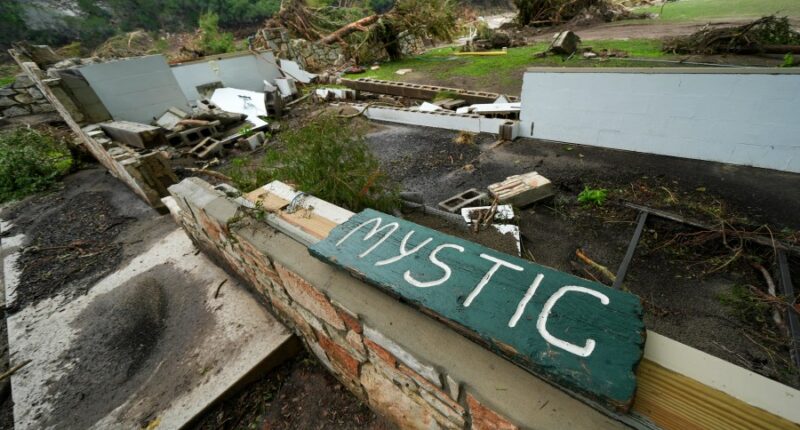Share this @internewscast.com

KERR COUNTY, Texas (KXAN) – As calls for accountability continue surrounding the deadly flood in Kerr County, state inspection reports show a recent history of safety compliance at a girls’ summer camp that has become the epicenter of national debate since the July 4 tragedy.
A flash flood early Friday morning forced the Guadalupe River to rise more than 30 feet, spilling over its banks and into Camp Mystic. By Tuesday, officials said at least 27 from the camp were dead. Five girls and one counselor were still missing.
Concern over weather alerts and evacuation preparedness have surfaced at daily press briefings. Officials have largely said they remain focused on recovery efforts at this time, though some have called for an eventual, broader review to better understand what happened and how it can be prevented in the future.
Among the questions swirling is the level of readiness at the camp for such an event. While experts have said this specific weather pattern would have been difficult to forecast fully, newly-obtained Department of State Health Services inspection records indicate the camp was following guidelines and rules for safety and awareness – including having an emergency plan in place.
According to DSHS, youth camps are required to maintain such plans. An agency spokesperson told KXAN it does not maintain copies of those plans, but camps are required to post plans clearly in every building. Written plans are required to include disasters including flooding, and procedures for emergency shelter and for evacuation of each occupied building.
“DSHS reviews the camp’s emergency plans onsite during their annual inspection for the correct elements listed in the Texas Administrative Code,” the DSHS spokesperson added.
KXAN reviewed the camp’s latest inspection reports from 2023-2025, finding no major deficiencies. The most recent inspection was conducted by a DSHS employee on July 2 – just two days before the flood – then listing 386 campers and 64 staff members at the camp.
- READ: Camp Mystic 2025 State Inspection Report
In each report, inspectors checked if the camp had a qualified director, the right ratio of supervisors to campers, qualified oversight for hazardous activities and written personnel policies and practices. Its youth camp license was also valid through March 6 next year.
Bunks and buildings were also checked for compliance with building codes, fire hazards and life safety rules. Beds were checked to ensure adequate space for exit. The camp passed on all those items each of the past three years, according to DSHS.
DSHS also checked if the camp had required emergency plans, including written plans in case of a disaster posted at the camp’s administrative office or location. The camp was also required to notify staff and volunteers of the emergency plan and document training. All those items were answered “yes” each year and received DSHS approval, according to the last three years of reports.
In case of emergency
According to the reports, the staff included at least one certified lifeguard and one additional person on duty for every 35 campers when they were engaged in waterfront activities, and the camp also determined each child’s swimming ability and had a written swim test policy.
The reports also indicate lifesaving equipment “suitable for waterfront activity” was “immediately available in case of an emergency,” kept in “good repair and ready condition.”
The camp also had the appropriate medical staffing – a physician, registered nurse, licensed vocational nurse or person with an American Red Cross Emergency Response certificate – either on-site or on-call, the DSHS reports show. It also indicated there was an appropriate ratio of adult supervisors – one for every 10 campers or fewer.
While the National Weather Service issued flash flood warnings and local government and law enforcement social media posts warned to “move to higher ground immediately,” the young campers likely would not have seen those since cell phones, smart watches, iPads and anything with Wi-Fi capability were considered “unacceptable electronic devices” to bring and “not allowed,” according to a recent list of instructions sent to parents.
Sources have said, though, that counselors had cell phones and the inspection reports said the camp had “a telephone readily available for emergency use.”
State safety rules for camps
While Texas Administrative Code states camps should have emergency phones available in the first aid area, for emergency use, there is no mention of emergency radios in case of weather impacts to phone services. Additionally, campers must be instructed as to their actions in the event of a disaster or need to evacuate. Also, camp staff and volunteers must be made aware of related procedures during trainings and briefings.
Families who reunited with their children have heralded the heroic efforts of the Mystic camp counselors on social media. The Louisiana governor also praised the efforts of one counselor and rising Louisiana Tech senior Emma Foltz who he said “played an instrumental role in helping evacuate 14 of her campers to safety.”
As of last year, DSHS issued 376 youth camp licenses, according to DSHS. The agency does track compliance and disciplinary actions against youth camps. It noted three disciplinary actions against youth camps since 2023, but did not provide details other than failure to preclude camp staff with criminal convictions or deferred adjudication and not properly maintaining a swimming pool. The state has established a Youth Camp Advisory committee with several camping professionals. KXAN investigators have asked the state and several committee members about possible changes to emergency plans after the recent floods, but as of this report have not received a response.











